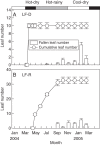Photosynthetic thermotolerance of woody savanna species in China is correlated with leaf life span
- PMID: 22875810
- PMCID: PMC3448426
- DOI: 10.1093/aob/mcs172
Photosynthetic thermotolerance of woody savanna species in China is correlated with leaf life span
Abstract
Background and aims: Photosynthetic thermotolerance (PT) is important for plant survival in tropical and sub-tropical savannas. However, little is known about thermotolerance of tropical and sub-tropical wild plants and its association with leaf phenology and persistence. Longer-lived leaves of savanna plants may experience a higher risk of heat stress. Foliar Ca is related to cell integrity of leaves under stresses. In this study it is hypothesized that (1) species with leaf flushing in the hot-dry season have greater PT than those with leaf flushing in the rainy season; and (2) PT correlates positively with leaf life span, leaf mass per unit area (LMA) and foliar Ca concentration ([Ca]) across woody savanna species.
Methods: The temperature-dependent increase in minimum fluorescence was measured to assess PT, together with leaf dynamics, LMA and [Ca] for a total of 24 woody species differing in leaf flushing time in a valley-type savanna in south-west China.
Key results: The PT of the woody savanna species with leaf flushing in the hot-dry season was greater than that of those with leaf flushing in the rainy season. Thermotolerance was positively associated with leaf life span and [Ca] for all species irrespective of the time of flushing. The associations of PT with leaf life span and [Ca] were evolutionarily correlated. Thermotolerance was, however, independent of LMA.
Conclusions: Chinese savanna woody species are adapted to hot-dry habitats. However, the current maximum leaf temperature during extreme heat stress (44·3 °C) is close to the critical temperature of photosystem II (45·2 °C); future global warming may increase the risk of heat damage to the photosynthetic apparatus of Chinese savanna species.
Figures




Similar articles
-
Leaf thermotolerance in tropical trees from a seasonally dry climate varies along the slow-fast resource acquisition spectrum.Sci Rep. 2017 Sep 12;7(1):11246. doi: 10.1038/s41598-017-11343-5. Sci Rep. 2017. PMID: 28900253 Free PMC article.
-
In thermotolerance tests of tropical tree leaves, the chlorophyll fluorescence parameter Fv/Fm measured soon after heat exposure is not a reliable predictor of tissue necrosis.Plant Biol (Stuttg). 2025 Jan;27(1):146-153. doi: 10.1111/plb.13732. Epub 2024 Oct 29. Plant Biol (Stuttg). 2025. PMID: 39468934 Free PMC article.
-
Photosynthetic acclimation to light changes in tropical monsoon forest woody species differing in adult stature.Tree Physiol. 2005 Aug;25(8):1023-31. doi: 10.1093/treephys/25.8.1023. Tree Physiol. 2005. PMID: 15929933
-
Leaf surface traits and water storage retention affect photosynthetic responses to leaf surface wetness among wet tropical forest and semiarid savanna plants.Tree Physiol. 2017 Oct 1;37(10):1285-1300. doi: 10.1093/treephys/tpx092. Tree Physiol. 2017. PMID: 28985388
-
Environmental stress - what can we learn from chlorophyll a fluorescence analysis in woody plants? A review.Front Plant Sci. 2022 Dec 14;13:1048582. doi: 10.3389/fpls.2022.1048582. eCollection 2022. Front Plant Sci. 2022. PMID: 36589121 Free PMC article. Review.
Cited by
-
Biogeochemistry: As different as night and day.Nature. 2013 Sep 5;501(7465):39-40. doi: 10.1038/501039a. Nature. 2013. PMID: 24005410 No abstract available.
-
Leaf thermotolerance in dry tropical forest tree species: relationships with leaf traits and effects of drought.AoB Plants. 2017 Dec 11;10(1):plx070. doi: 10.1093/aobpla/plx070. eCollection 2018 Feb. AoB Plants. 2017. PMID: 29354258 Free PMC article.
-
Sources of variability in seagrass fatty acid profiles and the need of identifying reliable warming descriptors.Sci Rep. 2023 Jun 20;13(1):10000. doi: 10.1038/s41598-023-36498-2. Sci Rep. 2023. PMID: 37340008 Free PMC article.
-
Ethylene involvement in the regulation of heat stress tolerance in plants.Plant Cell Rep. 2022 Mar;41(3):675-698. doi: 10.1007/s00299-021-02675-8. Epub 2021 Mar 13. Plant Cell Rep. 2022. PMID: 33713206 Review.
-
The physiological cold tolerance of warm-climate plants is correlated with their latitudinal range limit.Biol Lett. 2018 Aug;14(8):20180277. doi: 10.1098/rsbl.2018.0277. Biol Lett. 2018. PMID: 30158139 Free PMC article.
References
-
- APG III. An update of the Angiosperm Phylogeny Group classification for the orders and families of flowering plants: APG III. Botanical Journal of the Linnean Society. 2009;161:105–121.
-
- Bilger H-W, Schreiber U, Lange OL. Determination of leaf heat resistance: comparative investigation of chlorophyll fluorescence changes and tissue necrosis methods. Oecologia. 1984;63:256–262. - PubMed
-
- Chapotin SM, Razanameharizaka JH, Holbrook NM. Water relations of baobab trees (Adansonia spp. L.) during the rainy season: does stem water buffer daily water deficits? Plant, Cell and Environment. 2006;29:1021–1032. - PubMed
-
- Chen H-H, Shen Z-Y, Li PH. Adaptability of crop plants to high temperature stress. Crop Science. 1982;22:719–725.
-
- Corlett RT. Impacts of warming on tropical lowland rainforests. Trends in Ecology and Evolution. 2011;26:606–613. - PubMed

